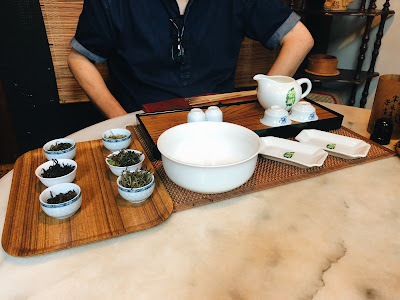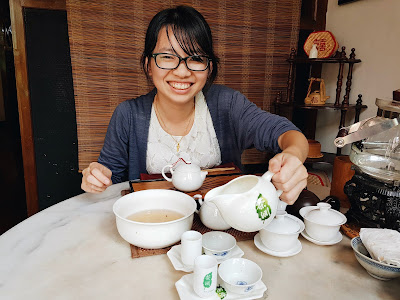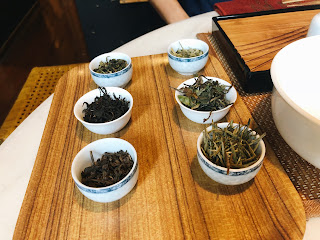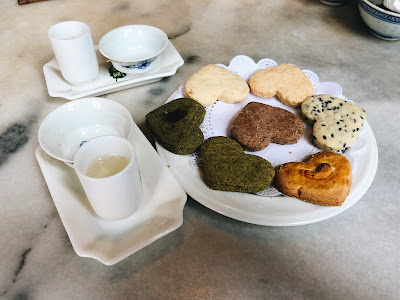On Sunday, I went for the Tea Chapter Tea Appreciation workshop! They have a tea appreciation course, but that takes place over a few days and costs about $200, so we went for the one-day course, well it was an hour or two but you get time to drink the teas so it took us an afternoon, that used six teas and cost about $60+ per person (minimum 2 people needed). There’s also a $35+ course, but that only lets you try 2 teas, so I think the $60+ course is more worth it.
 |
| The set up |
The tea master (just going to call him shifu here) can speak both English and Chinese. We opted to have the class in Chinese, though, because that would let him go into more detail. And anyway he uses pretty layman terms and English if needed so it was really easy to understand. Shifu was an extremely engaging and entertaining teacher and I learnt so much from him! I wish I could take notes but it would look weird so here are bits and pieces of the lesson:
The history of Tea
– Tea was first thought of as medicine and people used it in soups and dishes (and in Taiwan you can get tea leaf tempura! The shifu said that after we brew the tea we can put it in dishes and it would be good + get all the nutrients)
– There used to be a saying that we shouldn’t drink tea with medicine but that’s not true. Tea brewed at the normal strength is totally fine to have with medicine.
– Also, tea is cooling so if you need it to be warmer, add ginger or red sugar.
– People used to drink tea out of bowls. And for some reason, that reminded me of the Japanese word for rice bowl, which is 茶碗 (ちゃわん; chawan) and literally translates “tea bowl”. Which gave me a “so that’s where the name came from!” moment.
– There is also a Chinese saying “兴于唐,盛于宋” (hope I remembered that right). So basically it’s a summary of tea in the Tang and Song dynasties. Tea started flourishing in the Tang dynasty, although it was in the form of cakes. Also, the tea was salty. In the Song dynasty they would also whip the tea into foam and make tea art – way before the age of the cappucino! The one who ‘wins’ is the one whose tea art lasts the longest.
– Chinese tea took its modern form in the Ming dynasty.
– Mongolian milk tea is salty! When the mongols were introduced to tea, they didn’t have much water so they used milk instead.
Drinking & Appreciating Tea (Hands-on Section)
– All teas (even black teas) should be rinsed once with hot water before brewing because they’ve been touched by many many hands!
Since we took the 6 tea class, we got to try all six types of tea! This was probably the most fun part, although I also found the history fascinating because the books I’ve read have been pretty focused on the history of tea in the West.
Green tea: We tried the longjing tea and according to the shifu, the best longjing is tea harvested in before qingming (I think he said the ten days before qingming?) Also, the quality of tea really depends on when you harvest it – there’s a saying that it’s a treasure at one time, but a few days later it’s basically grass.
White tea: There’s a saying: “one year tea, three years medicine, seven years treasure” (一年茶、三年药、七年宝). Basically, white tea is packed with anti-oxidants and gets better as it ages!
Yellow tea: I was super excited for this because I’ve never tried yellow tea before! So apparently this tea isn’t sold by tea chapter because it’s really rare and really difficult to drink because if you overbrew it, the tea becomes bitter. When it’s brewed properly, it’s got a very faint taste, so you need to calm down and use your ‘spirit’ to drink the tea as well. It had a slight vegetal taste for me that I quite liked, although when we got to brew it ourselves after, we left the water in a bit too long and understood what it meant by bitter (though it tasted like matcha to me).
Red tea: We drank red guan yin (红观音), which is basically red tea made from tea leaves that would otherwise be made into tie guan yin.
Oolong: This tea was made in a special tea pot made out of clay with no glaze. The more you wash the teapot in the tea, the shinier it gets. Plus you can’t use soap to wash it or use it for more than one type of tea because it absorbs the tea. For this tea, we saved the water from the first rinse to pour over the tea pot. The tea we drank was the Imperial Golden Cassia and the ‘Imperial’ part of the name comes from the fact that Queen Elizabeth when she visited Tea Chapter in 1989! I found this post from them which has more information about the tea.
Pu-er: Fresh pu-er is green tea, aged pu-er is dark tea. Apparently, there is a pu-er from Wuyi called Da Hong Pao. Of the original trees, only six trees are left and they produce about 500g of tea a year. Which means that if someone tries to sell you ‘Da Hong Pao’ tea, it’ll either be a blend or from second/third generation trees grown cuttings from the original trees (which have a similar taste to the tea produced by the original four trees). The tea from the original trees is reserved for VIPs.
We also received tea eggs and a variety of cookies, some made with tea, some made without. The tea cookies were green tea, jasmine tea, and rose tea. All were really good.
 |
| Me trying to brew tea |
After the lesson, we were given as much time as we want to drink the teas and enjoy the cookies. If you’re looking for a one-day/afternoon workshop that will give you the basic knowledge of tea, you should definitely consider this!
Details
Webpage
Address: 9 & 11 Neil Road, Singapore 088808
Contact numbers (we called to make a reservation): Tea House (+65) 6226 1175 / (+65) 6226 1917
Retail Shop (+65) 6226 3026
Opening Hours
Tea House Business Hours
Sun – Thurs: 11.00 am to 09:00 pm
Fri – Sat, Public Holiday: 11.00 am to 10.30 pm
Retail Shop Business
Sun – Thurs: 10.30 am to 09:00 pm
Fri – Sat, Public Holiday: 10:30 am to 10.30 pm
Price: $35 for the workshop with two teas, $60 for the workshop with 6 teas. Prices do not include the 10% service charge.


